Tag archives: exoplanets
Citizen science, astronaut growth, water-flipping physics
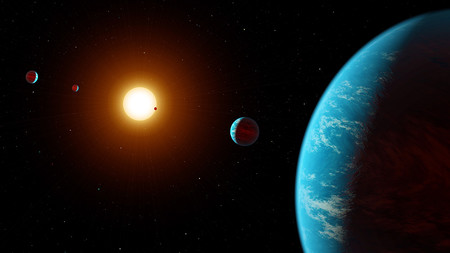
Planet hunting (courtesy: NASA/JPL-Caltech/R. Hurt)
By Michael Banks
This week the American Astronomical Society is meeting in Washington, D.C. At the conference it was announced yesterday that a citizen-scientist project called Exoplanet Explorers had used data from the Kepler mission to detect a new five-planet system.
The 27 authors include, among others, the astronomer and broadcaster Chris Lintott and the particle physicist and broadcaster Brian Cox. Exoplanet Explorers was featured prominently on the Australian TV show Stargazing Live in April and another author on the paper is the Australian TV presenter Julia Zemiro, who is affiliated with the Australian Broadcasting Corporation. You can read the paper here. (more…)
View all posts by this author | View this author's profile
Dialogues on physics, great women who changed science, a virtual reality journey to six exoplanets
By Hamish Johnston
I spend an hour or so every day looking at physics-related websites including several dozen blogs by professional physicists. One of my favourites is Asymptotia by Clifford Johnson, a theoretical physicist at the University of Southern California. Johnson is a talented visual artist and next month he has a new graphic book out called The Dialogues. The above video gives you a taste of what to expect. (more…)
View all posts by this author | View this author's profile
The Doomsday Clock ticks over 70 years, an exoplanet Westeros
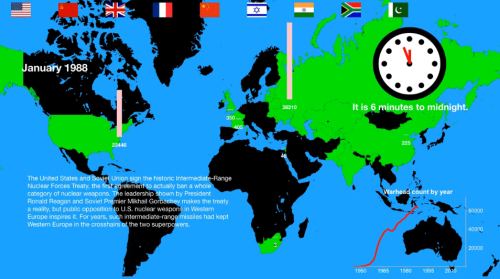
Circa 1988: the Doomsday Clock during safer times. (Courtesy: The Bulletin of the Atomic Scientists)
By Hamish Johnston
This year marks the 70th anniversary of the Doomsday Clock that is produced by The Bulletin of the Atomic Scientists. Currently at two and a half minutes to midnight, the clock represents the likelihood of a human-caused global catastrophe. Originally, it focused exclusively on a nuclear Armageddon, but in 2007 climate change and other technologically-driven processes were added to the mix. The clock was initially set at seven minutes to midnight in 1947 and the Bulletin has produced a video that charts the ups and downs over the past seven decades. Is there any good news? In the image above you can see that South Africa was a nuclear power in 1988, and it has since disarmed.
View all posts by this author | View this author's profile
Exoplanet christening, physics on the catwalk, ultrasonic wine

Quick spirit: ultrasonic waves speed up the ageing process. (CC BY-SA 3.0 Bbadgett)
By Sarah Tesh
Last week NASA announced the major find of seven Earth-like exoplanets orbiting a nearby dwarf star. The news that at least three of the seven could possibly support life was reported far and wide. Yet, as with most astronomical finds, the planets do not have the most imaginative names. Simply named after the star they orbit, they are currently called TRAPPIST-1a to TRAPPIST-1h. So NASA took to Twitter with the request #7NamesFor7NewPlanets and the public delivered. Suggestions have included the names of lost astronauts, famous composers and ancient deities. But naturally, there were also some less sensible contributions, including the seven dwarfs, many Harry Potter references, dedications to Pluto and, obviously, Planet McPlanetface 1 to 7.
View all posts by this author | View this author's profile
A laser-bubble mermaid, ode to seven exoplanets, metallic hydrogen is lost
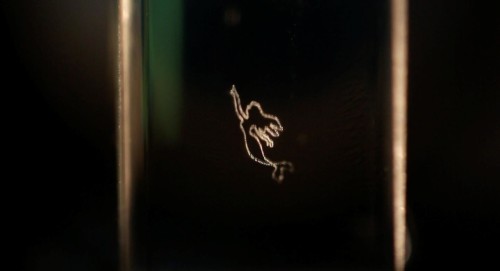
Tiny bubbles: a laser-made mermaid. (Courtesy: Kota Kumagai/ Utsunomiya University)
By Hamish Johnston
A popular way of melding science and art is to create an image of a mythical being in your lab. Yoshio Hayasaki and colleagues at Utsunomiya University in Japan have made a pretty good likeness of a mermaid using a laser that forms tiny bubbles inside a liquid. “In our display, the microbubble voxels are three-dimensionally generated in a liquid using focused femtosecond laser pulses,” explains team member Kota Kumagai.
View all posts by this author | View this author's profile
Feedback on a scheme to cloak Earth from hostile aliens
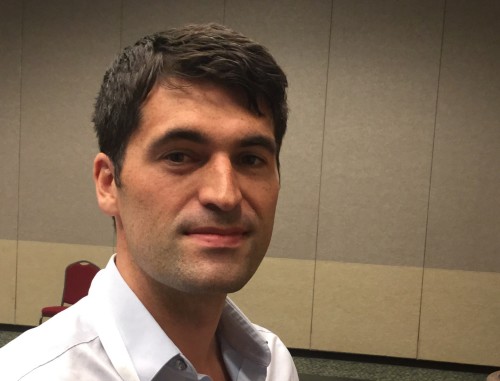
David Kipping doesn’t want to hide from aliens.
By Hamish Johnston at the APS April Meeting in Salt Lake City
Earlier today I caught up with David Kipping of Columbia University in the US after his fascinating talk about what could make an exoplanet habitable. I wanted to ask Kipping about a quirky paper that he and Alex Teachey published a few weeks ago, which I wrote about in the The Red Folder.
Kipping and Teachey described how a laser could be used to cloak the Earth from the prying eyes of an extraterrestrial civilization. The paper was published just before 1 April, so at the time I wasn’t sure whether the paper was legitimate (it is) and Kipping told me that publishing before April Fools’ Day did cause some confusion.
So what feedback has Kipping had about the paper?
Thwarting an alien invasion, pi in the sky, listening to the LHC and more
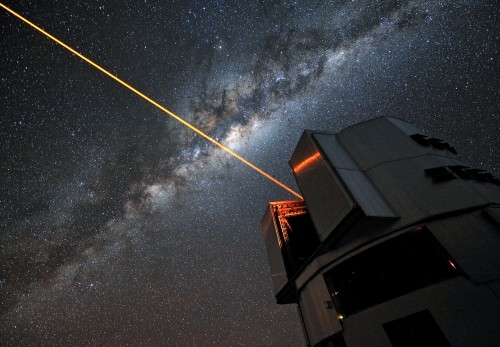
Not bright enough: this adaptive-optics laser would have to be a million times brighter to cloak the Earth. (Courtesy: ESO/G Hüdepohl)
By Hamish Johnston
Sometimes, the biggest laughs on April Fools’ Day come from the stories that read like hoaxes but are actually true. One such item is a proposal by David Kipping and Alex Teachy of Columbia University in the US, who have come up with a way of hiding the Earth from aggressive civilizations on distant planets (at least I think this is real, but I wouldn’t be surprised if it were an elaborate hoax!).
View all posts by this author | View this author's profile
Twin alien civilizations, the ancient genetics of cancer, and marvellous Maxwell and his wonderful equations
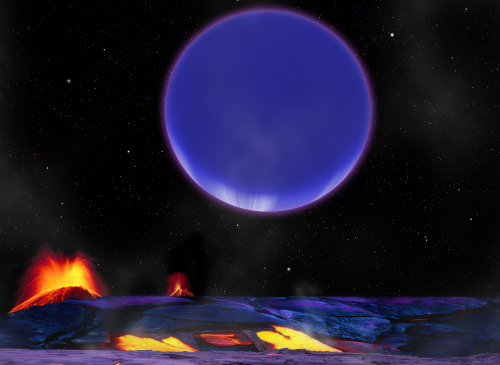
It’s raining life: could two nearby planets exchange living organisms? An artist’s impression of one planet in the Kepler 36 system as seen by its neighbour.
(Courtesy: Harvard-Smithsonian Center for Astrophysics/David Aguilar)
By Hamish Johnston and James Dacey
There is an intriguing article about alien life this week in The Conversation. “Twin civilizations? How life on an exoplanet could spread to its neighbour” is by David Rothery of the Open University and is a popular account of a paper that will soon be published in the Astrophysical Journal. The paper is inspired by the star Kepler 36, which has two planets that are in very close proximity to each other. While the Kepler 36 worlds are not suitable for life, the paper’s authors – Jason Steffen and Gongjie Li – explore possible exchanges of life between two Earth-like planets in similarly close orbits. Rothery explains that debris flung off one of the planets would stand a good chance of finding its way to the surface of the other planet after a relatively brief journey through space.
Radiation blasts render Earth’s twin inhospitable to life
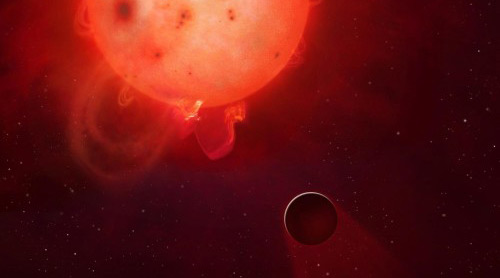
Radioactive? Kepler-438b is regularly irradiated by huge flares of radiation from its host star. (Courtesy: Mark A Garlick/University of Warwick)
By Tushna Commissariat
In the past decade or two, exoplanetary research has been booming as NASA’s Kepler telescope and its cohorts have found nearly 2000 exoplanets and 5000 promising candidates. Unsurprisingly, we have been searching long and hard for those planets that could be habitable or are as similar in shape, size and proximity to the host star as the Earth is to the Sun. Indeed, in January this year Kepler scientists announced that they had found the most Earth-like planet to date – Kepler-438b – orbiting within the habitable zone of its host star, the red dwarf Kepler-438, which lies about 470 light-years from Earth.
The planet, which is slightly bigger than our own, was found to be rocky, and, thanks to its location, rather temperate, meaning that it could have flowing water on it – two key factors that astronomers look for when accessing a planet’s habitability. Unfortunately, David Armstrong of the University of Warwick in the UK and colleagues have now found that Earth’s twin is regularly bathed in vast quantities of radiation from its star – a real dampener when it comes to the formation of life as we known it.
View all posts by this author | View this author's profile
Going underground to discuss alien life
By James Dacey
“Genuinely, it could be our generation that first finds life on another planet,” declared astrobiologist Lewis Dartnell last Thursday during a public talk in London. Dartnell was speaking about the possibility of life beyond Earth and what those organisms might be, based on our understanding of life here on Earth. The choice of venue – a pedestrian tunnel near King’s Cross Station bathed in neon lights – brought an appropriate alien vibe to the evening. Part of the reason for choosing the site is because if humans were to one day colonize Mars we would need to spend the first few years living underground to avoid the lethal radiation.